
| Home | Deepsky Atlas | TheAstronews | Links | Solar System | ||||||

Hawaiian Astronomical SocietyConstellations: Orion -- A Life of Sex and Violence |
||||||||||
One spring day, he traveled to the island of Chios (Khios, located 5 miles off the western coast of Turkey in the Aegean Sea). King Oenopion ruled the land. He had a beautiful daughter named Merope (not to be confused with Merope of the Pleiades). Orion fell madly in love with her and asked her father for permission to marry her.
The king didn't like the idea of letting her go, so he gave Orion the seemingly impossible task of ridding the island of its dangerous wild beasts, hoping he would fail. He told Orion he would permit the marriage when he finished the task. Orion worked very hard for several months from dawn to well after sunset, until the job was done.
He went to claim Merope, but King Oenopion hesitated to give his daughter away, and told Orion that he hadn't finished his job completely. By now Orion had figured out the real situation. He got very drunk one night and in a fit of rage, took Merope by force. The next morning, Merope told her father that Orion had raped her. The king was angered by the disturbing news, but somewhat glad of having good reason to get rid of him. The next night, Oenopion got Orion drunk again, blinded him and cast him out on the seashore.
An oracle told Orion that he would see again if he went east and let the rays of the rising sun fall on his eyes. The blinded hunter traveled as far as Lemnos (Limnos, located midway between Mt. Athos and the Turkish coast in the Aegean Sea), and there he recovered his eyesight.
Eos, the goddess of the dawn had watched over Orion since he had left Chios and fell in love with him. Orion spent some wonderful times with Eos, before deciding to return to Chios to gain revenge on Oenopion. When the king discovered Orion returned, he immediately hid in a secret cave. Orion searched for the king, but could find him.
Bent on revenge, Orion journeyed to the island of Crete searching for King Oenopion, but he was nowhere to be found. There he met the beautiful Artemis, goddess of the Moon and as keen a hunter as Orion. She thought she had finally found someone special to fall in love with, and the feelings were mutual. Orion was so much in love that he abandoned his ideas of revenge.
Her twin brother, Apollo, (god of light, music, poetry, healing, prophecy, and manly beauty) soon discovered their love affair. His sister was so involved with Orion that she forgot to carry the Moon across the sky. After a month without the Moon, Apollo complained to his sister, but she paid no attention to him. Apollo was disgusted with his sister and thought the only way to solve this problem was to kill Orion.
One day Apollo sent Orion to the sea to catch some fish. When Orion waded through the sea, his head just above water, Apollo called his sister and pointed out the unrecognizable black dot far away. He tauntingly told her that although she was good with her bow, even she had her limits, and it was highly unlikely that she could hit the tiny target. Artemis felt insulted, immediately fit an arrow to her bow, and shot the target. Her aim was perfect, as always. The arrow pierced Orion's head, killing him instantly.
The waves rolled Orion's dead body to the shore. Artemis was horrified to discover her mistake. She wept and wept in deep sorrow. She took Orion's body to her nephew Esculapius (god of medicine and healing), begging him to revive Orion. Before Esculapius could act, a thunderbolt from Zeus destroyed Orion's body. Artemis finally accepted his death, and set her lover among the stars.
There is another story about Orion's death. Orion boasted he was the greatest hunter in the universe. When Zeus' wife, Hera, heard his claims, she grew furious, and sent a poisonous scorpion to kill him. The creature snuck in and stung him to death. Zeus took a pity on Orion, and placed him in the heavens, where he appears as a giant, with girdle, sword, lion's skin, and club. Hera placed the scorpion in the heavens at the opposite end of the sky. Even now, Orion tries to avoid the scorpion until it has set. Scorpius, on the other hand, rises in the east when a few of Orion's stars still linger above the western horizon.
The ancient Egyptians saw much of Orion as embodying the god Osiris.
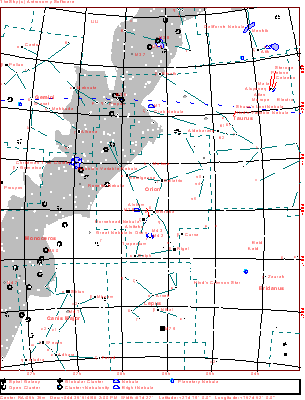
Click the map for a 916x1200 version of the above. Click here for a map better suited for use in the field.
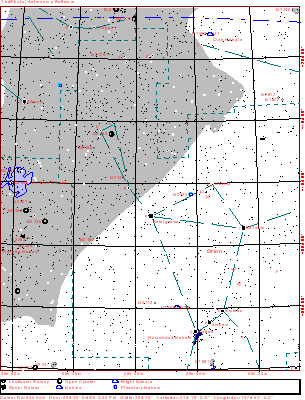
This a more detailed view of the constellation. The map displays stars to magnitude 10, and deepsky objects to magnitude 12. Click here for a map better suited for use in the field.
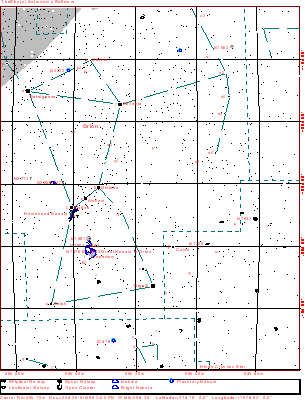 >
>Click here for a map better suited for use in the field.

| 65k Jpeg Photographer's notes: Color CCD ST6 RGB 6-9-24 Min Doug Clapp. 66k JPEG.
M78 (NGC2068) is that piece of nebulosity no-one looks at in Orion. Located about 3° NNE of Alnitak (the easternmost belt star), Dreyer describes it as bright, large, wispy and brighter toward the middle.
|
 52k JPEG NGC2024 (Best 75, and sometimes called the Flame Nebula) is a piece of faint nebulosity surrounding Alnitak, visible in medium (6") and larger scopes. The actual nebulosity is quite large, and extends toward Orion's sword to include the Horsehead Nebula. 52k JPEG NGC2024 (Best 75, and sometimes called the Flame Nebula) is a piece of faint nebulosity surrounding Alnitak, visible in medium (6") and larger scopes. The actual nebulosity is quite large, and extends toward Orion's sword to include the Horsehead Nebula.
Photographer's notes:10 minute exposure of the Flame Nebula in Orion taken with an ST7 and 9 micron pixels. 12 inch Meade LX200 at F3.3. Adrian Catterall |
 30k JPEG A one shot colour Image of the Flame Nebula taken with the Starlite Xpress colour camera by Terry Platt. 30k JPEG A one shot colour Image of the Flame Nebula taken with the Starlite Xpress colour camera by Terry Platt.
|
|
 80k JPEG NGC1981 is the northernmost "star" in Orion's sword. It is actually an open cluster (mag4.6) consisting of 20 bright (mag 6.3) stars spread over a 25' field. It includes the double star Struve 750 (mags. 6 and 8 with a separation of 4.3"), and Struve 743 (mags. 6.9 and 8 with a separation of 1.8"). 80k JPEG NGC1981 is the northernmost "star" in Orion's sword. It is actually an open cluster (mag4.6) consisting of 20 bright (mag 6.3) stars spread over a 25' field. It includes the double star Struve 750 (mags. 6 and 8 with a separation of 4.3"), and Struve 743 (mags. 6.9 and 8 with a separation of 1.8").
|
 30k JPEG NGC1973 (Best 74) is a piece of nebulosity just north of the Great Nebula, and probably a part of it. Photo by Jason Ware. 30k JPEG NGC1973 (Best 74) is a piece of nebulosity just north of the Great Nebula, and probably a part of it. Photo by Jason Ware.
|
Image to the left is a drawing through an 8" telescope by Jere Kahanpää. Image to the right is an edited Digital Sky Survey image.
|
The Great Nebula (M42, NGC1976) is one of the most wonderful objects in the sky, rivaled only by the Milky Way near Eta Carinae. Visible to the naked eye (at mag. 4) in Orion's sword, it is the birth place of countless stars.
 21k JPEG The classic, heavily processed, David Malin Photo. Includes M43 toward the top. 21k JPEG The classic, heavily processed, David Malin Photo. Includes M43 toward the top.
|
 42k JPEGPhotographer's notes: Expansive view of most of the Orion Nebula (M42) including M43 and much of NGC1977. The dark dusk lane separating the M42/43 complex from NGC1977 is prominent. Image: 10 min. ST-7 (9u pixels) on 4" f/5 (Genesis), logarithmically scaled, then linearly scaled. 42k JPEGPhotographer's notes: Expansive view of most of the Orion Nebula (M42) including M43 and much of NGC1977. The dark dusk lane separating the M42/43 complex from NGC1977 is prominent. Image: 10 min. ST-7 (9u pixels) on 4" f/5 (Genesis), logarithmically scaled, then linearly scaled.
|
 120k JPEG Photographer's notes: This is a false color super-dynamic-range wide-field view of M42/M43 which reveals deep extended nebulosity down to the 4 stars of the trapezium. Image is a composite of 3 CCD exposures (5 seconds; 2 minutes; 45 minutes) using an ST-7 on a 4" f/5 Genesis. View in 24 bit Color. 120k JPEG Photographer's notes: This is a false color super-dynamic-range wide-field view of M42/M43 which reveals deep extended nebulosity down to the 4 stars of the trapezium. Image is a composite of 3 CCD exposures (5 seconds; 2 minutes; 45 minutes) using an ST-7 on a 4" f/5 Genesis. View in 24 bit Color.
|
 157k JPEGThis deep image of the Orion Nebula was taken from a "self contained portable observatory" setup in a mountain at 7,000 ft elevation in Death Valley. Equipment: 4" f/5 refractor (Genesis), GM-8 mount, ST-7 CCD camera. Image: Mosaic of 2 30 minute exposures. Log scaling and false color used to extend dynamic range. Stan Moore 157k JPEGThis deep image of the Orion Nebula was taken from a "self contained portable observatory" setup in a mountain at 7,000 ft elevation in Death Valley. Equipment: 4" f/5 refractor (Genesis), GM-8 mount, ST-7 CCD camera. Image: Mosaic of 2 30 minute exposures. Log scaling and false color used to extend dynamic range. Stan Moore
|
 16k JPEG Just another gorgeous image of the Orion Nebula. 16k JPEG Just another gorgeous image of the Orion Nebula.
|
 17k JPEG This is a detail of M43 (NGC1982) from the David Malin photo above. M43 is part of the Great Nebula complex in the sword of Orion. Dreyer describes it as very bright, very large, rich with a tail, and with some condensation. Amateurs just look at the whole complex and say nothing. 17k JPEG This is a detail of M43 (NGC1982) from the David Malin photo above. M43 is part of the Great Nebula complex in the sword of Orion. Dreyer describes it as very bright, very large, rich with a tail, and with some condensation. Amateurs just look at the whole complex and say nothing.
|
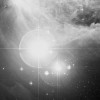 80k JPEG From a description by Steve Coe: "NGC 1980 Faint, large, irregular, not brighter in the middle at 100X. This nebula surrounds Iota ORI, the end star on the sword of Orion. If you are like me, the first time you looked at NGC 1980, you didn't know that you were looking at an object that has a separate designation from the Great Orion Nebula." Image from the Digital Sky Survey with a considerable amount of logarithmic scaling. 80k JPEG From a description by Steve Coe: "NGC 1980 Faint, large, irregular, not brighter in the middle at 100X. This nebula surrounds Iota ORI, the end star on the sword of Orion. If you are like me, the first time you looked at NGC 1980, you didn't know that you were looking at an object that has a separate designation from the Great Orion Nebula." Image from the Digital Sky Survey with a considerable amount of logarithmic scaling.
|
Image on the left is a drawing through an 8" telescope at 40x by Jere Kahanpää. Image on the right is an edited Digital Sky Survey image, showing both the star 73 Orionis, and a small planetary nebula (197-2.1 in TheSky) to the lower, left.
|
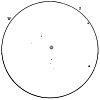 10k GIF NGC2022 (Best 76) is a planetary nebula located on a line between Betelgeuse (Alpha Orionis) and Meissa (Lambda Orionis), about 2/3 of the way to the latter. Described as fairly bright (mag. 12.4), very small (28"x27"), and very little elongated, it responds to a nebula filter and higher magnifications. A 13" telescope shows brightening in the middle, but no central star. Smaller aperture shows a fairly even, gray disk. 10k GIF NGC2022 (Best 76) is a planetary nebula located on a line between Betelgeuse (Alpha Orionis) and Meissa (Lambda Orionis), about 2/3 of the way to the latter. Described as fairly bright (mag. 12.4), very small (28"x27"), and very little elongated, it responds to a nebula filter and higher magnifications. A 13" telescope shows brightening in the middle, but no central star. Smaller aperture shows a fairly even, gray disk.
Image is a drawing through an 8" telescope at 160x by Jere Kahanpää.
|
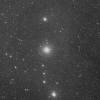 94k JPEG Collinder 69 consists of the 1° area around Meissa (Lambda Orionis). Here is a description by Susan French of an observation made with a 4" refractor at 17x, from the Internet Amateur Astronomers Catalog: "Cr 69 consists of the three bright stars of Orion's head plus about 40 more in 1o. The surrounding nebulosity is very large and shows up faintly with the OIII filter." Image from the Digital Sky Survey. 94k JPEG Collinder 69 consists of the 1° area around Meissa (Lambda Orionis). Here is a description by Susan French of an observation made with a 4" refractor at 17x, from the Internet Amateur Astronomers Catalog: "Cr 69 consists of the three bright stars of Orion's head plus about 40 more in 1o. The surrounding nebulosity is very large and shows up faintly with the OIII filter." Image from the Digital Sky Survey.
|
If you have any questions about the Hawaiian Astronomical Society
please
(link requires javascript).